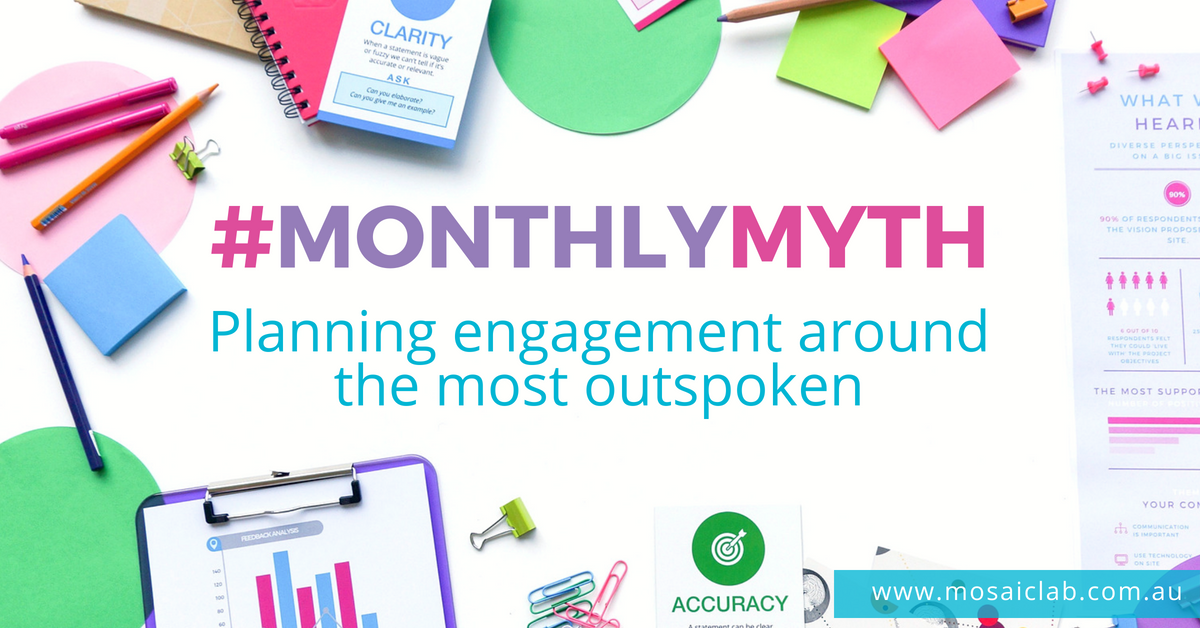It’s important to consider and tailor your engagement approach to ensure you meet the needs of all stakeholders, and that includes those who have the most to say.
This mistake, however, lies in forgetting about everyone else. It’s an error that has a habit of sneaking up on you. Suddenly, you realise the needs and opinions of a few have demanded time, attention and resources at the expense of the rest of your stakeholders or community. In the end, your engagement approach suffers, because you’re trying to flex it around one person or one group.
The worst approach (and a surprisingly common tactic) is to conduct private conversations with specific individuals or groups – a move that seems unfair and suspicious to the wider community, and often results in outrage, distrust or disengagement.
Today we’re addressing this myth by providing 9 ways to avoid making this mistake in your next process.
IN REALITY:
Engagement processes are only representative if they include diverse views. In fact, ensuring diverse perspectives are included in your process will actually help you to engage with those who are outspoken or hold entrenched positions more effectively.
The people who are stepping forward, speaking up and expressing strong opinions naturally command your attention. It can be tempting to put a lot of effort into responding to or planning around these individuals or groups. It’s incorrect, however, to assume that these people are automatically representative of the whole community. Often the bravest or most invested people speak up - but thatdoesn’t mean there aren’t others who are passionate about or impacted by the decision.
Why do people choose not to participate?
There's a range of reasons for a lack of diverse participation. A few common reasons for this include:
people lack of confidence when it comes to sharing their views publicly,
there are barriers to engaging with you (like timing, location, language etc.) or that activities don’t meet diverse needs,
people feel uncomfortable or unsafe participating - usually a result of poorly planned or poorly facilitated sessions that make people feel intimidated or 'on the outer',
people believe that their view isn't truly valued in your process, or that they won't have any impact over the outcome.
So how do you ensure that diverse voices and perspectives make it into your process?
1. Analyse comprehensively. Conduct a thorough stakeholder analysis and understand ‘the whole system’ – don’t wait for stakeholders to present themselves and assume that’s everyone.
2. Go to the source. Talk to representatives from a diverse range of groups across your community and ask them how best to engage with them and what barriers might prevent them from participating.
3. Make the effort. Specifically target those less likely to participate or be represented in standard activities. For example, organise small group conversations at times and locations that suit participants.
4. Consider activities and channels. Think about the way people can receive information and get involved - diverse channels and options encourage a diverse range of people to participate.
5. Know who’s in the room. Face to face sessions should be run in a way that encourages everyone present to contribute, so ensure you create a space that welcomes everyone.
6. Invest in facilitation. An experienced facilitator will support conversations in a way that’s inclusive, encourages participation and sharing of ideas and gets the most out of a group.
7. Let people know. Clearly and consistently communicate that your organisation wants to hear everyone’s views and that diverse perspectives will be valued and included.
8. Get random. Random, independent selection – stratified to ensure the group is broadly representative of key demographics in the wider community - can be included in one or more phases of your engagement process.
9. Actively seek out other views. Identify and connect with those who have a different view. Understanding their perspectives will help you plan better, broaden your own understanding and tap into a different cohort.
We've summarised all the top tips from this post into a handy free download. Perfect for sharing, printing, filing, or whatever you want really! Click the image to subscribe to our monthly e-newsletter the discussion and grab this free resource.
OVER TO YOU
How do you encourage diverse perspectives in your engagement processes? Share your ideas in the comments below.
ENJOYED THIS POST?
Stay in the know! Get new posts, actionable ideas and fabulous free resources delivered to your inbox - subscribe to our monthly e-newsletter 'the Discussion'.



